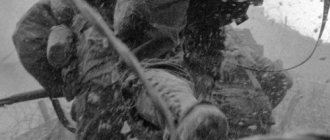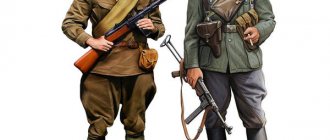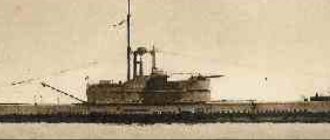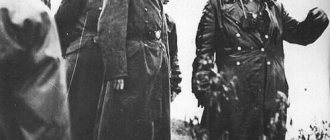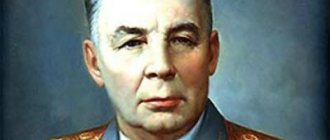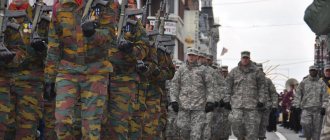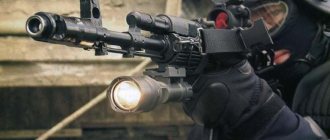Organization[edit]
The organizational structure of this SS formation was as follows: [14]
| Designation (English) [15] | Designation (German) [16] |
|
|
- Composition of the 5th SS Panzer Division (1940): [17] SS Regiment Germany 1st Battalion
- 2. Battalion
- 3. Battalion
- 1. Battalion
- 1. Battalion
- 1. Battalion
Commanders [edit]
| No. | Commander | Took office | Left office | Time in the office |
| 1 | Steiner, Felix SS Obergruppenführer Felix Steiner (1896–1966) | December 1, 1940 | May 1, 1943 | 2 years, 151 days |
| 2 | Gille, Herbert SS-Gruppenführer Herbert Gille (1897–1966) | May 1, 1943 | August 6, 1944 | 1 year, 97 days |
| 3 | Deisenhofer, Eduard Standartenführer SS Eduard Deisenhofer (1909–1945) | August 6, 1944 | August 12, 1944 | 6 days |
| 4 | Mühlenkamp, Johannes Standartenführer SS Johannes-Rudolf Mühlenkamp (1910–1986) | August 12, 1944 | October 9, 1944 | 58 days |
| 5 | Ulrich, Karl SS Oberführer Karl Ulrich (1910–1996) | October 9, 1944 | May 5, 1945 | 208 days |
Links[edit]
Quotes [edit]
- Jump up
↑ McNab, pp. 167, 178 - McNab, page 167
- ↑
Stein, pp. 103, 104 - Stein, page 103
- McNab, page 178
- ^ ab Littlejohn (1987) p. 53.
- ^ a b Stein (1984) p. 238.
- Dollinger (1967) p. 182.
- Jump up
↑ Rhodes, Richard (2003).
Masters of Death: The SS-Einsatzgruppen and the Invention of the Holocaust
. item 63, Vintage. - ^ a b Lappin
- ^ ab Olav Tuff (91): Vi brente en kirke med sivilister
- Ei ny fortid [New past] "Bestefaren Per Pedersen Tjøstland var frontkjempar i 5. SS Panzer Division" Viking "from 1941–1943, and skreyve for a German tank. Hans eigne dagbøker and artiklar er ei hovudkjelde, men Jackson umulig å vite nøyaktig kva han var med på. Kanskje seier det sitt at han bruker uttrykket "så rensket vi et jødehull" "
- "What made this man Josef Mengele?" New York Times
. The New York Times Company (Section 6): 16, Column 1. July 21, 1985 - Williamson Gordon. "Hitler's SS instrument of power." KAISER, appendix, p. 244, "Schlachtordnung der Waffen-SS / Waffen-SS Battle Order"; copyright 1994 Brown Packaging Books Ltd., London.
- MILITÄRISCHES STUDIENGLOSAR ENGLISCH Teil II / Teil III, Deutsch - Englisch, Abkürzung Begriff, Bundessprachenamt (Stand Januar 2001).
- ↑
Official designation "Bundesarchiv-Militärarchiv" in Freiburg im Breisgau, Wehrmacht and Waffen-SS depots. - Baxter, Ian (05/30/2018). 5th SS Viking Division in the War 1941-1945: History of the Division. Pen & Sword Books Limited. ISBN 9781526721341.
Bibliography[edit]
- Lifton, Robert Jay (1985). “What made this man Mengele?” . New York Times Company. Archived from the original on April 18, 2009. Retrieved March 29, 2009.
- Dollinger, Hans (1967) [1965]. The Decline and Fall of Nazi Germany and Imperial Japan. New York: Bonanza. ISBN 978-0-517-01313-7.
- Lappin, Eleanor. "Death Marches of Hungarian Jews through Austria" (PDF). Yadvashem. Archived from the original on February 19, 2009 (PDF). Retrieved March 28, 2009. pp. 25–26
- Littlejohn, David (1987). Foreign Legions of the Third Reich Vol.
1 Norway, Denmark, France . Bendery publishing house. ISBN 978-0912138176. - McNab, Chris (2013). Hitler's Elite: The SS 1939-45
. Osprey Publishing. ISBN 978-1782000884. - Stein, George H (1984). Waffen SS: Hitler's Elite Guard at War, 1939–1945
. Cornell University Press. ISBN 0-8014-9275-0. - Struve, Kai (2015). Deutsche Herrschaft, ukrainischer Nationalismus, antijüdische Gewalt [ German rule, Ukrainian nationalism and anti-Semitic violence: Summer 1941 in Western Ukraine
] (in German). Berlin, Germany: De Gruyter Oldenbourg. ISBN 9783110359985.
| vteWaffen-SS Divisions | |
| Panzer |
|
| Tank Grenadier |
|
| mountain |
|
| Cavalry |
|
| Infantry |
|
| Police |
|
| Deception Units |
|
| Lists |
|
| |
| vthGerman tank divisions from World War II | |
| Army | |
| Named |
|
| to book |
|
- 1st SS Division Leibstandarte
- 2nd SS Division Das Reich
- 3rd SS Division Totenkopf
- 5th SS Viking Division
- 9th SS Division Hohenstaufen
- 10th SS Division Frundsberg
- 12th SS Division Hitlerjugend
- 1st Division Hermann Goering
| Access to portals related topics |
|
| Wikipedia's sister projects |
|
| Authoritative control |
|
Formation and training [edit]
After the invasion of Poland in 1939, SS chief Heinrich Himmler attempted to expand the Waffen-SS with foreign military volunteers for the Nazi "crusade against Bolshevism". Recruitment began in April 1940 with the creation of two regiments: the Waffen-SS Nordland Regiment (for Danish, Norwegian and Swedish volunteers) and the Waffen-SS Westland Regiment (for Dutch and Flemish volunteers). [1]
Scandinavian formation, originally organized as Nordische Division
(Nr. 5), was to consist of Nordic volunteers mixed with ethnic German Waffen-SS soldiers.
The SS Germania infantry regiment of the SS-Verfügungs
, formed mainly from ethnic Germans, was transferred to form the core of the new division in late 1940.
[2] In December 1940, a new motorized SS formation was to be called SS-Division Germania, but after a formation period the name was changed to SS-Division Wiking in January 1941. [3] The division was formed around three motorized infantry regiments: Germania, Westland and Nordland; with the addition of an artillery regiment. Command of the newly formed division was given to Felix Steiner, former commander of the SS regiment Verfügungstruppe Deutschland
. [4]
Once formed, the division was sent to Heuberg in Germany for training; by April 1941 he was ready for battle. In mid-May, the division was ordered east to take part in Army Group South's advance into Ukraine during Operation Barbarossa, the invasion of the Soviet Union. [5] In June 1941, the Finnish Waffen-SS volunteer battalion was formed from volunteers from this country. This unit was attached to the SS regiment Nordland division. About 430 Finns who participated in the Winter War served in the SS Viking Division from the beginning of Barbarossa's reign. In the spring of 1943, the Finns' two-year contract ended and the Finnish battalion was withdrawn. At the same time, the Nordland regiment was removed to form the core of the new SS division Nordland. They were replaced by the Estonian Narva infantry battalion. [6]


